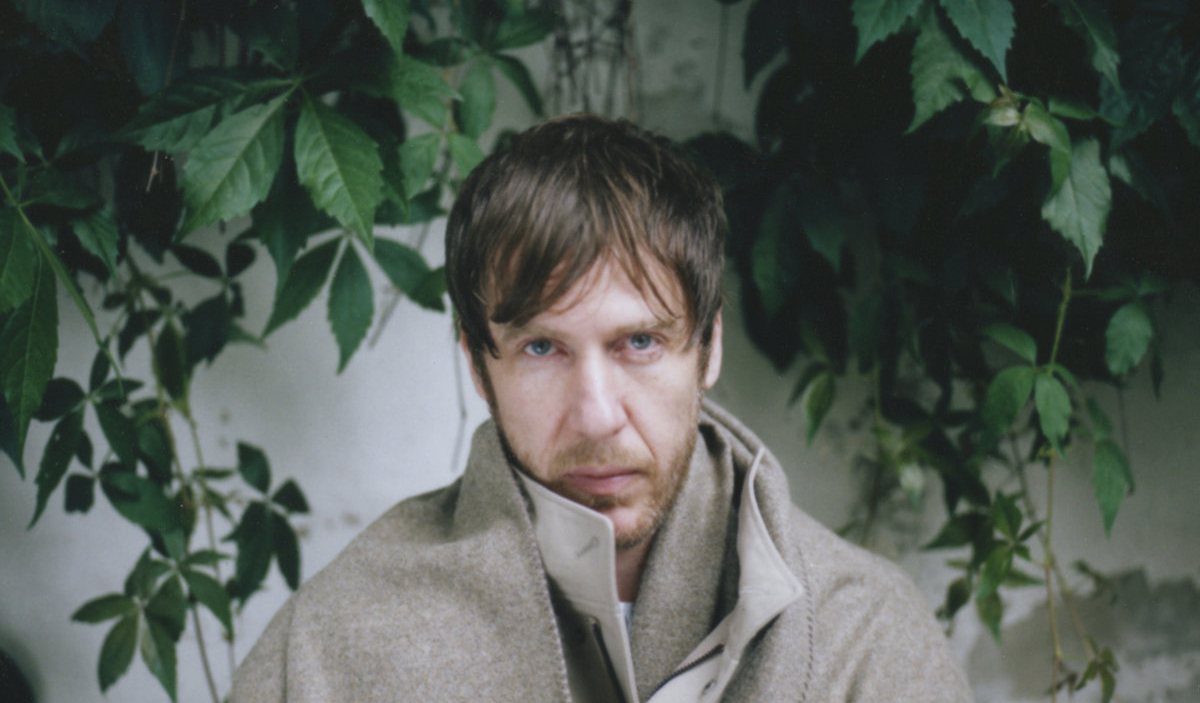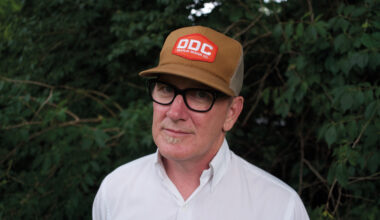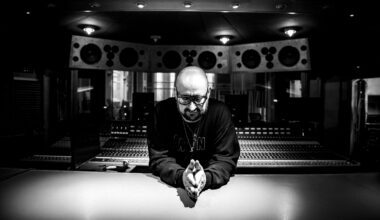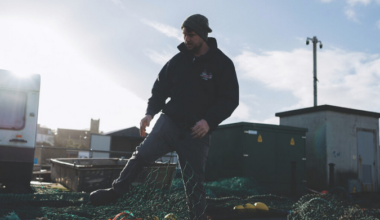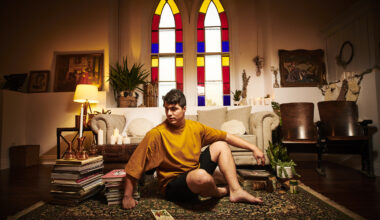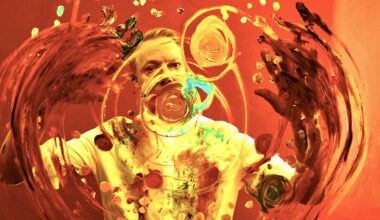Leaving behind the big name remixes and opulent studio productions of Death In Vegas, Richard Fearless is going it alone under his own name. His debut solo album, ‘Deep Rave Memory’, paints a picture every bit as vivid as the spectacular views afforded by his River Thames studio
At the point where the River Lea becomes the Thames, you’ll find Richard Fearless’ studio. He’s housed in one of the repurposed shipping containers dotted around a former industrial space that has been transformed into a hub of creativity, where music producers, artists, theatre and opera companies have moved in.
The site is dominated by London’s only lighthouse. The 19th century scientific genius Michael Faraday once worked here, solving the problem of lightbulbs steaming up the glass of the lighthouse windows, with a reciprocal team on the distant Shooter’s Hill some six miles away taking readings. These days it’s home to an installation by Jem Finer, once a member of The Pogues, which is emitting an installed composition that will take 1,000 years to play out. Fearless is convinced that his pitch, closest of all to the point at which the two rivers join, is a spot of positivity and health.
“Where you’ve got two rivers converging,” he explains, “it’s really powerful to have that energy. When water bangs into itself it produces negative isotopes, which are very good for you apparently. We need them in our body and we don’t get enough of them. That’s why walking on a beach feels really good, it’s the water molecules rubbing against each other.”
But when it comes to inspiration, the negative isotopes are just the tip of the iceberg. Visiting, as we do, after dark, this part of London’s heritage takes on a new and almost space age personality. Planes from the nearby City Airport launch themselves into the air at seemingly perilous angles above your head. The cable cars that traverse the river during the day lie dormant, glowing red in the dark, while the lights of the 02 directly opposite, on the south side of the Thames, sparkle in the turbulent waters.
To our right, the startlingly vivid skyline of Canary Wharf looks on like a towering alien landscape that would be more at home in North America or China. To the left, the stark white light of a factory where massive construction girders are made around the clock pours over the river towards us. Fearless says he loves the way the light reflects off the water and the industrial noises the factory produces. On a very basic level, when he’s working through the night it’s great to feel that he’s not the only person still awake in the world.
“It’s a small studio but what isn’t small is this long view,” he says. “I feel like I’ve got a lot of space when I work here, when I stand here and I’m looking out on the water.”
But there’s a deeper resonance to this place that runs in tandem with what he calls this Ballardian landscape. A psycho-geographic memory linked to the East India Company, slavery and the roots of capitalism and the City of London, and beyond that, to the sacrifices and rituals that surround the ancient Thames. Memory, after all, is part of what we’re here to talk about.
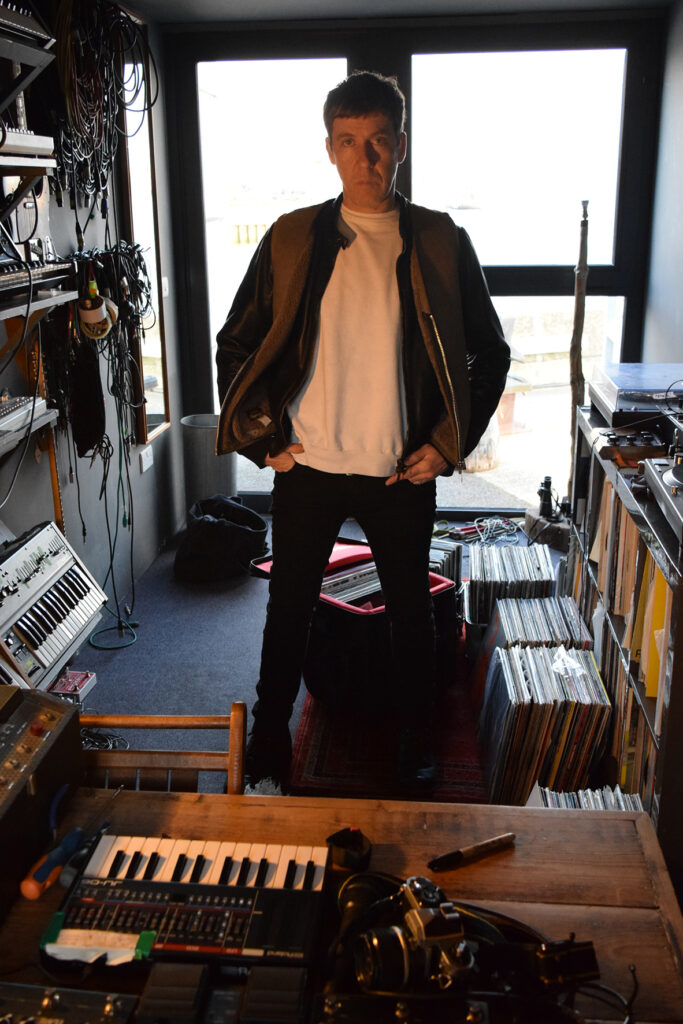
‘Deep Rave Memory’ is the first Richard Fearless solo album, a remarkable techno journey that cuts a markedly different musical path to Death In Vegas, the project he’s most closely associated with. Where Death In Vegas elicits thoughts of big name remixes and collaborations with high profile singers like Bobby Gillespie and Liam Gallagher, ‘Deep Rave Memory’ is purely instrumental and impressionistic, starting from the barely perceptible ambient tones of ‘Vision Of You’, building into atmospheric, eerie techno worthy of gracing any smoke-filled dancefloor at 3am, before winding down to closer ‘Broken Beauty’.
The idea behind this lone pursuit started simply as an opportunity to make a few low-key singles, but snowballed into an album when the feedback outstripped expectations. Although Fearless says there was no firm concept in place when he started making the record, now that it’s finished he can see the parallels with a night out, from getting ready to its climax.
“I was playing it to Daniel Avery the other day,” he says, “and he said, ‘It sounds like you when you’re DJing’. Although I hadn’t thought about that, that is kind of what I wanted the Richard Fearless stuff to be like, like the repertoire in my box. People tend to think of me as Death In Vegas, but I was a techno DJ before that and I’ve always seen them as very different sides of me. I’ve never played Death In Vegas records when I’m DJing, but doing this I thought I can be a bit more reflective of the Chicago and Detroit records that I’ve always loved.”
While there are the odd reference points (he mentions the dark, reverb-affected electronics of Mika Vainio, which influenced the original sequences and had the ‘Ginger Snaps’ EP by Jamal Moss in mind when constructing the slippery, skidding drum sounds) the main inspiration is much wider, he says.
“It’s about 30 years of electronic music, 30 years of record buying and digging. It’s about remembering certain moments, certain feelings…”
For Fearless, acid house was like his punk, the moment his generation found their own music.
“Before that, all the bands I was into, The Stooges, Velvet Underground, were older people’s bands, and then all of a sudden My Bloody Valentine came along and then acid house came along it was like just such a powerful thing. I started art school at that time and I remember it being such a mentally liberating time in my life.”
Does he remember his first rave, or the moment the music first clicked for him?
“It was a rave in Chislehurst Caves, actually. The tablets we had on the way didn’t seem to be working and then I heard this song, ‘Made In Two Minutes’ by Bug Kann & The Plastic Jam, and everything kicked in at the same time. Every time I hear that song I think back to that car full of northern mates.”
When we suggest there’s a tremendous sense of freedom to the new record, Fearless laughs and points out that it’s true, in a very literal way.
“I don’t have anyone involved in my career,” he says. “I don’t have any management, I don’t have a record label, and I’m not signed to a publisher any more, so I can do these projects without someone saying, ‘What’s going to be the single?’.”
He laughs at the thought of breaking the news to a label that the single – in this case the album’s centrepiece, the jerky beautiful motor funk of ‘Deep Rave Memory’ itself – is going to be 12 minutes long and there’s no narrative to the video. Having said that, directed by Richard Cunningham’s enigmatically named former assistant and friend 241247, it’s a psychedelic masterpiece in its own right, constructed from hundreds of individual photographs taken by Fearless.
Fearless has always had a hand in the visual side of his releases via artwork, but in recent years photography has become increasingly important. So much so that he has plans to turn ‘Deep Rave Memory’ into an art installation featuring the “rave cloud”, as he puts it, that he created and shot lasers at to create the album’s distinctive, impressionist cover image.
It’s the kind of project, we venture, that might have been scoffed at as being pretentious a couple of decades ago, but in this multimedia age seems natural. For Fearless, though, it’s another example of the freedom that his new DIY set up affords.
“It’s really liberating,” he beams. “I feel at this stage in my career the only way I can do it is to make it creatively exciting.”
Significantly, it was to photography that he turned when, in his own words, he “overloaded” and took drastic steps to clear his creative decks and pressed the mental reset button. At the time, the beginning of 2004, he was working all day in the studio with Oasis and dashing home to prepare for DJ sets. In addition, having chalked up Death In Vegas’ biggest success with the high-profile vocally embellished ‘Scorpio Rising’, he submitted an entirely instrumental album (‘Satan’s Circus’) to his label… and was promptly dropped.
“I just thought I can’t listen to any more music, I kind of overloaded,” he recalls. “In the end, I didn’t want to listen to anything, I wanted to listen to art.”
His solution was to up sticks to New York, where he studied photography at the International Center of Photography, funding the course under a scheme by which he could work as a teaching assistant. Death In Vegas had been signed when he was in college the first time round, so although he did finish his degree, he’d been too distracted to fully benefit from the experience. But going back to college as an “old student” was a dream, he says. “I would do an MA tomorrow if I could.”
Those experiences, he says, led directly to what he’s working on now, both musically and business wise. After years of production and remix credits on high-profile projects, he says he now turns down any commercial work, “which is hard, because I’m supporting a family, but it’s the only way I can do this right.”
Instead, he’s concentrating his efforts on his own label, Drone, whose other activities include a forthcoming Fearless-produced album from experimental rock provocateurs Selfish Cunt and recent singles from Christopher Rau, Tommy Vicari Jr and PSSU, his collaboration with Daniel Avery.
Despite having inhabited some of the most luxuriously equipped studios in the world, he’s stuck to the same fairly spartan set up.
“I like to give myself constraints,” he says. “I’ve produced in studios where there’s loads of gear and it’s a bit overwhelming because people are like, ‘I want to use this, I want to use that’.”
So, alongside, a Moog keyboard – out being serviced when we visit – there are two drum machines, a Roland 606 and a 909, the latter with its parts split and fed through a Roland Space Echo RE-201, an Echolette E51, an Echoplex and two Effectron II digital delays. It’s all triggered and synched using three sequencers – a Roland MC 202, a Korg SQ-10 and a SAM-16 made by the SND Company set up by Kraftwerk’s synthesiser engineer Sebastian Niessen.
“Everything is outboard gear, so everything is done before I start recording it,” he explains. “That’s a big part of how I work. There’s no putting something down and then looking in a box to see what effects to use on it.”
However, the foundations for ‘Deep Rave Memory’ started with a five-day session in Hamburg, laying down sequences.
“I wanted to use certain instruments that I didn’t have, so I went to Hamburg where I’d recorded a lot of the last Death In Vegas album to the synthesiser studio there, which is this fantastic place that has two System 100s – I did a lot of ‘Transmission’ there. Really, I wanted to go there to use a couple of things, the PPGs and System 100s, a few other bits like Tridents, machines that I didn’t have.”
Hamburg’s presence is significant beyond mere hardware though, as it’s become a spiritual home of sorts for Fearless in recent years. Germany in general has kept faith with his sound and he’s enjoyed a residency at Berlin’s legendary Tresor nightspot. But there’s clearly a special place in his heart for Hamburg, where he’s made repeat visits to the city’s Golden Pudel club to play epic sets, gradually building up from dub to full on techno.
“I’ve spent a lot of time in Hamburg because of Golden Pudel and I love it there,” he says, “It’s such an amazing, open-minded club with absolutely faultless programming. It’s a club that’s had a massive influence on the whole movement of the city, musically, with people like Smallville, Dial, Christopher Rau… lots of artists have come from that scene. The last time I was there, the first person who came in was like a wizard with a staff, the next guy was a dread with this old lady wearing fairy wings, then three hipsters after that. Then you get people working in the docks coming in too, it’s wild.”
As well as all that, of course, is the water. It’s not lost on Fearless that the beloved city is a port.
“I always seem to be attracted to water,” he says, “even in New York I lived by the docks. There’s something about the sense of space it gives you.”
That and the abundance of those lovely negative isotopes, of course. Whatever, the Fearless plan of quite literally going with the flow, seems to be yielding some uniquely positive results.
‘Deep Rave Memory’ is out on Drone
